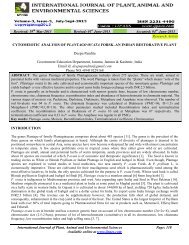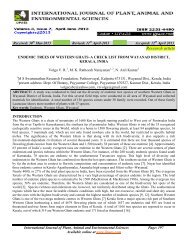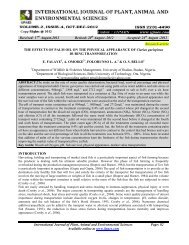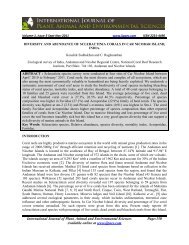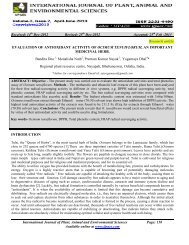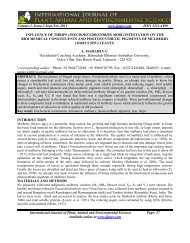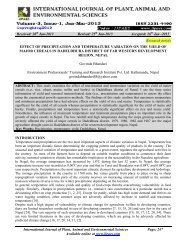biobleaching and delignification of hard wood kraft pulp ... - Ijpaes.com
biobleaching and delignification of hard wood kraft pulp ... - Ijpaes.com
biobleaching and delignification of hard wood kraft pulp ... - Ijpaes.com
Create successful ePaper yourself
Turn your PDF publications into a flip-book with our unique Google optimized e-Paper software.
Received: 18 th May-2013 Revised: 27 th May-2013 Accepted: 30 th May-2013<br />
Research Article<br />
BIOBLEACHING AND DELIGNIFICATION OF HARD WOOD KRAFT PULP (HWKP) BY<br />
TRAMETES SP., GANODERMA SP. AND PORIA SP.<br />
K. Selvam,* <strong>and</strong> K. Arung<strong>and</strong>hi<br />
Department <strong>of</strong> Biotechnology, Dr.N.G.P Arts <strong>and</strong> Science College, Coimbatore-641048, Tamilnadu, India.<br />
*Corresponding author, e-mail: selsarat@yahoo.<strong>com</strong><br />
ABSTRACT: In the present study, White rot fungi Trametes sp., Ganoderma sp. <strong>and</strong> Poria sp. were collected from<br />
decayed <strong>wood</strong> <strong>of</strong> Tamir<strong>and</strong>us indica, Eucalyptus gr<strong>and</strong>is <strong>and</strong> Tectonia gr<strong>and</strong>is respectively from the western ghats<br />
region <strong>of</strong> Tamilnadu <strong>and</strong> Karnataka in India. The collected fungi were isolated <strong>and</strong> identified based on the<br />
morphological characters from the key provided previously. The collected fungi were examined for <strong>biobleaching</strong> <strong>and</strong><br />
<strong>delignification</strong> <strong>of</strong> <strong>hard</strong> <strong>wood</strong> <strong>kraft</strong> <strong>pulp</strong> (HWKP). In <strong>biobleaching</strong> <strong>and</strong> <strong>delignification</strong> <strong>of</strong> HWKP, all the three fungi<br />
reduced the kappa number <strong>and</strong> increased the brightness <strong>of</strong> the <strong>pulp</strong> after 10 days <strong>of</strong> incubation. The maximum<br />
reduction in kappa number (12.76%) <strong>and</strong> brightness (44.87%) were determined in Poria sp.<br />
Keywords: Biobleaching, Trametes sp., Ganoderma sp. <strong>and</strong> Poria sp . Hard <strong>wood</strong> <strong>kraft</strong> <strong>pulp</strong> (HWKP).<br />
INTRODUCTION<br />
Removal <strong>of</strong> lignin from <strong>wood</strong> is the first step in the manufacturing <strong>of</strong> chemical paper <strong>pulp</strong>s <strong>and</strong> the most <strong>com</strong>mon<br />
process [1]. Residual lignin in <strong>kraft</strong> <strong>pulp</strong> is highly modified by alkaline condensation reactions during <strong>pulp</strong>ing <strong>and</strong><br />
gives the <strong>pulp</strong> a characteristic dark brown colour. This residual lignin is <strong>com</strong>mercially removed by bleaching with<br />
chlorine based chemicals. The chlorinated products derived from lignin during these bleaching procedures are<br />
mutagenic they also cause a waste treatment problem because <strong>of</strong> their toxicity <strong>and</strong> dark colour. Therefore,<br />
environmental concerns have led us to seek alternative ways to eliminate or at least reduce the use <strong>of</strong> chlorine based<br />
chemicals in bleaching. Increasing awareness about environmental concerns has led the paper industry to look for<br />
cleaner production which aimed at the reduced consumption <strong>of</strong> chlorine <strong>and</strong> its <strong>com</strong>pounds in the bleaching sequences<br />
which thereby minimizes the discharge <strong>of</strong> chlorinated organic such adsorbable organic halides (AOX) in the effluent<br />
[2]. The kappa number is the volume <strong>of</strong> 0.1N potassium permanganate solution consumed by one gram <strong>of</strong> moisture<br />
free <strong>pulp</strong> <strong>and</strong> the results are corrected to 50 per cent consumption <strong>of</strong> the permanganate added. In recent year’s paper<br />
mills are adopting eco friendly technologies such as oxygen <strong>delignification</strong>, enzymatic pre bleaching. Bioleaching has<br />
number <strong>of</strong> advantages such as reduction <strong>of</strong> AOX levels in discarded effluents <strong>and</strong> improved <strong>pulp</strong> quality gain in<br />
brightness [3]. Pretreatment <strong>of</strong> <strong>wood</strong> chips with proper fungi results in significant energy <strong>and</strong> chemical savings <strong>and</strong><br />
allows for an improved paper quality [4]. The importance <strong>of</strong> microbial enzymes in <strong>pulp</strong> <strong>and</strong> paper manufacturing has<br />
grown significantly in the last two decades [5]. White rot fungi can degrade lignin <strong>and</strong> a range <strong>of</strong> environmental<br />
pollutants by many <strong>of</strong> their extra cellular ligninolytic enzymes. The use <strong>of</strong> white rot fungi for the biological<br />
<strong>delignification</strong> <strong>of</strong> <strong>wood</strong> was first studied at the West Virginia <strong>pulp</strong> <strong>and</strong> paper <strong>com</strong>pany in the 1950’s [6, 7]. The first<br />
to recognize that P. chrysosporium could partially delignify s<strong>of</strong>t <strong>wood</strong> unbleached <strong>kraft</strong> <strong>pulp</strong>. It was also reported that<br />
<strong>hard</strong><strong>wood</strong> unbleached <strong>kraft</strong> <strong>pulp</strong> treated with T. versicolor showed an increase in brightness <strong>and</strong> a corresponding<br />
decrease in residual lignin concentration [8, 9]. The beneficial effects <strong>of</strong> bleaching by the white rot fungi<br />
Ceriporiopsis subvermispora, P. chrysosporium <strong>and</strong> Trametes (Coriolus) versicolor. Several modified <strong>kraft</strong> <strong>pulp</strong>ing<br />
methods have been developed over the past 30 years, representing a large improvement in <strong>kraft</strong> <strong>pulp</strong>ing technology.<br />
Removal <strong>of</strong> lignin from <strong>wood</strong> is the first step in the manufacturing <strong>of</strong> chemical paper <strong>pulp</strong>s <strong>kraft</strong> alkaline <strong>pulp</strong>ing<br />
being the most <strong>com</strong>mon process [10]. Pulping <strong>and</strong> bleaching <strong>of</strong> <strong>kraft</strong> <strong>pulp</strong> uses large amount <strong>of</strong> chlorine <strong>and</strong> chloride<br />
chemicals the products <strong>of</strong> these chemical are chlorinates organic substance. Some <strong>of</strong> which are toxic <strong>and</strong> mutagenic in<br />
the biological systems. Some lignin oxidizing enzymes such as manganese peroxidase <strong>and</strong> laccase shower the<br />
potential for <strong>biobleaching</strong> reaction by specific lignin oxidation removal by white rot fungi have the significant role in<br />
bleach <strong>kraft</strong> <strong>pulp</strong> [11].<br />
International Journal <strong>of</strong> Plant, Animal <strong>and</strong> Environmental Sciences Page: 96<br />
Available online at www.ijpaes.<strong>com</strong>
Selvam <strong>and</strong> Arung<strong>and</strong>hi Copyrights@2013 IJPAES ISSN 2231-4490<br />
The bleaching agents used in <strong>pulp</strong> <strong>and</strong> paper industries are chlorine, alkali, hypochloride <strong>and</strong> hydrogen peroxide. The<br />
use <strong>of</strong> chlorine based chemicals in the bleaching process generates chlorophenol <strong>com</strong>pounds which are <strong>com</strong>pletely<br />
resistant to microbial attack <strong>and</strong> remain as recalcitrants [12].<br />
MATERIALS AND METHODS<br />
Collection <strong>of</strong> fungi<br />
The fungi Trametes sp., Ganoderma sp. <strong>and</strong> Poria sp. were collected from Western Ghats area <strong>of</strong> Tamilnadu <strong>and</strong><br />
Karnataka, India <strong>and</strong> were isolated from decayed <strong>wood</strong> <strong>of</strong> Tamarindus indica, Eucalyptus gr<strong>and</strong>is <strong>and</strong> Tectonia<br />
gr<strong>and</strong>is respectively. The collection sight was situated in the latitude <strong>of</strong> -11.58 ° S <strong>and</strong> longitude <strong>of</strong> 76.93 ° E at 400 ±<br />
50M MSL. It receives rain fall <strong>of</strong> about 300 mm per year with high humidity <strong>and</strong> temperature. The collected samples<br />
were used for further studies.<br />
Fungi isolation<br />
The portion <strong>of</strong> the fungi was cut, surface sterilized with 1 per cent mercuric chloride solution <strong>and</strong> then repeatedly<br />
washed with sterile distilled water [13]. The fungi were then inoculated on 2 per cent malt agar medium in petriplates.<br />
Then the fungal growth which occurred on the plates were sub cultured on malt agar slants to obtain pure culture. The<br />
samples were identified based on the morphology <strong>of</strong> the fruiting bodies <strong>and</strong> spores on the key provided previously<br />
[14, 15].<br />
Preparation <strong>of</strong> spore suspension<br />
The fungi were grown in malt agar medium by dissolving 20 g <strong>of</strong> malt extract in distilled water <strong>and</strong> made up to 1000<br />
ml. The pH was maintained as 6.5 at 37 ° C then the plates were flooded with sterile distilled water <strong>and</strong> brushed with<br />
camel hair brush smoothly without disturbing the mycelial growth <strong>and</strong> filtered through a sterile filter. The<br />
concentration <strong>of</strong> the filtrate was adjusted to 10 5 spores/ml <strong>and</strong> inoculum was used for further studies.<br />
Biobleaching <strong>and</strong> <strong>delignification</strong> <strong>of</strong> <strong>hard</strong> <strong>wood</strong> <strong>kraft</strong> <strong>pulp</strong> (HWKP)<br />
The HWKP <strong>of</strong> Eucalyptus gr<strong>and</strong>is was obtained from Tamil Nadu Newsprint <strong>and</strong> Paper industry limited karur, Tamil<br />
Nadu, India. Mycological broth (200 ml) in a conical flask (500 ml) added with a glass bead (2.5 cm dia) <strong>and</strong> HWKP<br />
(0.25%) was inoculated with fungal spore suspension (10 5 spores/ml) <strong>and</strong> incubated with shaking (200 rpm) at 25°C<br />
for 5 days. After 5 days, the resulting suspension was inoculated (15% v/v) into 500 ml flasks containing sterile water<br />
(200 ml) <strong>and</strong> 1 or 2 per cent HWKP (dry weight basis). The flasks were incubated with shaking (200 rpm) at 25°C for<br />
2 to 10 days [16].<br />
Mycological broth<br />
Bactosoytone - 10.0 g<br />
D Glucose - 40.0 g<br />
*Trace element solution - 1.0 ml<br />
Distilled water - 1000 ml<br />
pH adjusted to - 4.5 to 5.0<br />
*Trace element solution<br />
FeCl 3 - 27.03 mg<br />
Na 3 C 6 H 5 O 7 - 24.97 mg<br />
CuSO 4 - 1176.4 mg<br />
ZnCl 2 - 24.97 mg<br />
MnSO 4 - 476.10 mg<br />
MgCl 2 - 338.02 mg<br />
CoCl 2 - 118.97 mg<br />
NiCl 2 - 2.377 mg<br />
(NH 4 ) 6 Mo 7 O 24 - 61.80 mg<br />
Distilled water - 100 ml<br />
Parameters studied<br />
The final pH, kappa number <strong>and</strong> brightness <strong>of</strong> the treated <strong>pulp</strong> were determined. The pH <strong>of</strong> the <strong>pulp</strong> solution was<br />
measured directly by using a pH meter. Kappa number <strong>and</strong> brightness were estimated from st<strong>and</strong>ard h<strong>and</strong> sheets<br />
prepared from the <strong>pulp</strong> after harvest.<br />
International Journal <strong>of</strong> Plant, Animal <strong>and</strong> Environmental Sciences Page: 97<br />
Available online at www.ijpaes.<strong>com</strong>
Selvam <strong>and</strong> Arung<strong>and</strong>hi Copyrights@2013 IJPAES ISSN 2231-4490<br />
Preparation <strong>of</strong> h<strong>and</strong> sheet<br />
To prepare the h<strong>and</strong> sheets (2x4 cm size), the <strong>pulp</strong> suspension was filtered through a Buchner funnel vacuum. The<br />
residue was blotted <strong>and</strong> air dried for 24 h.<br />
Kappa number (TAPPI, 1993)<br />
Kappa number is used as criteria for the lignin content <strong>of</strong> <strong>pulp</strong>s <strong>and</strong> is determined as the volume <strong>of</strong> 0.1 N<br />
potassium permanganate (ml) consumed by 1.0 g <strong>of</strong> moisture free <strong>pulp</strong>. A portion <strong>of</strong> the cut piece <strong>of</strong> h<strong>and</strong> sheets<br />
that could consume approximately 50 per cent <strong>of</strong> potassium permanganate solution (0.1%) was weighted out <strong>and</strong><br />
disintegrated in 500 ml distilled water until free <strong>of</strong> fibre clots or bundles. The disintegrated suspension was made up<br />
to 800 ml. To 100 ml <strong>of</strong> KMnO 4 solution (0.1 N), 100 ml <strong>of</strong> H 2 SO 4 (4 N) was added <strong>and</strong> cooled to 25°C <strong>and</strong><br />
immediately added to disintegrated h<strong>and</strong> sheet suspension. After 10 min, the reaction was stopped by adding 20 ml <strong>of</strong><br />
potassium iodide solution (1 N) <strong>and</strong> titrated against sodium thiosulphate solution (0.2 N). Starch solution (0.2 %) was<br />
used as the indicator. A blank titration was carried out in the same procedure but without <strong>pulp</strong>. The kappa number was<br />
calculated by the formula<br />
K= p x f / W<br />
<strong>and</strong><br />
P = (b-a) N / 0.1<br />
Where,<br />
K = Kappa number<br />
F = Factor for correction to the 50 per cent permanganate consumption<br />
depending on the volume <strong>of</strong> <strong>pulp</strong> (TAPPI, 1993)<br />
W = Weight <strong>of</strong> moisture free <strong>pulp</strong> sample used for estimation (g)<br />
P = Amount <strong>of</strong> 0.1 N permanganate consumed by the sample (ml)<br />
B = Amount <strong>of</strong> thiosulphate consumed in blank determination (ml)<br />
A = Amount <strong>of</strong> thiosulphate consumed by sample<br />
N = Normality <strong>of</strong> thiosulphate<br />
Correction for reaction temperature<br />
Pf<br />
K= ------ [0.0+0.013(25-t)]<br />
W<br />
Where,<br />
t = actual reaction temperature in degree Celsius.<br />
Brightness<br />
Brightness <strong>of</strong> the h<strong>and</strong> sheets were measured at 457 nm in a Perkin Elmer λ3B spectrophotometer equipped with a<br />
reflectance sphere.<br />
RESULTS AND DISCUSSION<br />
The results showed in table 1 <strong>and</strong> figure I, explained the treatment <strong>of</strong> HWKP by white rot fungi. The parameters were<br />
analysed for pH, kappa number <strong>and</strong> brightness (ISO units). The initial pH <strong>of</strong> the HWKP was 6.93, Kappa number was<br />
28.00 <strong>and</strong> brightness was 31.50 ISO units. In Trametes sp. treatment, HWKP pH had reduced to 4.59 from 6.93 after<br />
10 days <strong>of</strong> incubation period also the kappa number was reduced to 14.72 from 28.00, then the brightness was<br />
increased from 31.50 to 43.01 ISO Units. On the 10 th day <strong>of</strong> incubation period Ganoderma sp. reduced the pH 4.67<br />
from 6.93, Kappa number was reduced to 13.89 on the same day, brightness was increased up to 43.98 from 31.50<br />
ISO units. For Poria sp. the pH <strong>and</strong> kappa number had reduced to 4.36 <strong>and</strong> 12.76 ISO Units respectively. Increased<br />
brightness (44.87 ISO units) was observed on 10 th day. [10]. The pine <strong>kraft</strong> <strong>pulp</strong> was bleached in a totally chlorine<br />
free sequence that involved treatment with culture supernatant from white rot fungus Trametes troggi where as <strong>kraft</strong><br />
<strong>pulp</strong> from Eucalyptus globules was treated by Pycnoporus sanguienus at 40°C on pH 3.0 [17]. T. versicolor was<br />
shown to be capable <strong>of</strong> substantial depolarization <strong>and</strong> <strong>delignification</strong> <strong>of</strong> unbleached industrial <strong>kraft</strong> <strong>pulp</strong>s over 2 to 5<br />
days [18].<br />
International Journal <strong>of</strong> Plant, Animal <strong>and</strong> Environmental Sciences Page: 98<br />
Available online at www.ijpaes.<strong>com</strong>
Selvam <strong>and</strong> Arung<strong>and</strong>hi Copyrights@2013 IJPAES ISSN 2231-4490<br />
Table 1: Biobleaching <strong>and</strong> <strong>delignification</strong> <strong>of</strong> <strong>hard</strong><strong>wood</strong> <strong>kraft</strong> <strong>pulp</strong> (HWKP) by white rot fungi<br />
Incubation Final pH Kappa number Brightness (ISO units)<br />
period (days)<br />
Control<br />
Tr Gn Pr Tr Gn Pr Tr Gn Pr<br />
0 6.93 6.93 6.93 28.00 28.00 28.00 31.50 31.50 31.50<br />
2 6.39 6.42 6.01 26.80 26.20 24.93 34.98 35.01 35.08<br />
4 6.15 6.29 5.93 24.30 23.50 21.90 38.14 38.96 39.21<br />
6 5.92 5.84 5.23 20.34 19.89 19.23 40.26 41.13 42.17<br />
8 5.39 5.42 5.12 17.39 16.92 15.34 42.38 43.26 44.18<br />
10 4.59 4.67 4.36 14.72 13.89 12.76 43.01 43.98 44.87<br />
Tr: Trametes sp.; Gn: Ganoderma sp.; Pr: Poria sp Values are mean <strong>of</strong> three replicates<br />
Fig. I: Effect <strong>of</strong> fungal treatment on kappa number <strong>and</strong> brightness <strong>of</strong> HWKP<br />
International Journal <strong>of</strong> Plant, Animal <strong>and</strong> Environmental Sciences Page: 99<br />
Available online at www.ijpaes.<strong>com</strong>
Selvam <strong>and</strong> Arung<strong>and</strong>hi Copyrights@2013 IJPAES ISSN 2231-4490<br />
CONCLUSION<br />
Biobleaching <strong>and</strong> <strong>delignification</strong> <strong>of</strong> HWKP, all the three white rot fungi reduced the kappa number (12.76%) <strong>and</strong><br />
increased the brightness (44.87%) <strong>of</strong> the <strong>pulp</strong> on 10 days <strong>of</strong> incubation. But, the maximum reduction <strong>of</strong> kappa<br />
number <strong>and</strong> increased the brightness were noted in Poria sp.<br />
ACKNOWLEDGEMENT<br />
This research work was funded by University Grant Commission (UGC) major research project, No.F.35-31/2009<br />
(SR). The authors thank University Grant Commission (UGC) for their constant financial; support <strong>and</strong> guidance<br />
rendered throughout the period <strong>of</strong> study.<br />
REFERENCES<br />
[1] Re V. D, Kondo R <strong>and</strong> Thaker V. 2010. Bleaching <strong>of</strong> Hard<strong>wood</strong> Kraft Pulp with Manganese Peroxidase from<br />
Phanerochaete chrysosporium. Indust. Engin. Chem. Res., 46: 744-751.<br />
[2] Ander P, Eriksson K. E, Kolar M.C <strong>and</strong> K. P. Kringstad. 1977. Studies on the mutagenic properties <strong>of</strong> bleaching<br />
effluents. Microb. Technol., 80 : 454-459.<br />
[3] Thakur V. V, Jain R. K <strong>and</strong> Mathur R. M. 2012. Studies on xylanase <strong>and</strong> laccase enzymatic pre bleaching to<br />
reduce chlorine based chemicals during CEH ad ECF bleaching. Biores. Com., 7: 2220-2235.<br />
[4] Moreira R, Vara P. E. A, Martins S. G, Poloniam I, Malcata F. X <strong>and</strong> Duarte J. C, 2001. Decolourization <strong>of</strong><br />
remazol Brilliant Blue R via a noval Bjerk<strong>and</strong>era sp. Strain. Biotechnol, 89: 107-111.<br />
[5] Re V. D, Papinutti L , Villalba L , Forchiassin F , Levin L, 2008. Preliminary studies on the <strong>biobleaching</strong> <strong>of</strong><br />
loblolly pine Kraft<strong>pulp</strong> with Trametes trogii crude extracts, Enz. Microb.Technol., 43:164-168.<br />
[6] Lawson R. <strong>and</strong> Still M, 1957. Olive milling wastewater as a medium for growth <strong>of</strong> four Pleurotus sp. Appl.<br />
Biochem. Biotechnol, 31: 223-235.<br />
[7] Kirk T. K. <strong>and</strong> Yang H, H, 1979. Partial <strong>delignification</strong> <strong>of</strong> unbleached <strong>kraft</strong> <strong>pulp</strong> with ligninolytic fungi.<br />
Biotechnol. Lett., 1 : 347-352.<br />
[8] Paice M. G., Jurasek L, Ho C, Bourbonnais R <strong>and</strong> Archibald F, 1989. Direct biological bleaching <strong>of</strong><br />
<strong>hard</strong><strong>wood</strong> <strong>kraft</strong> <strong>pulp</strong> with the fungus Coriolus versicolor.TAPPI J., 72: 217-221.<br />
[9] Islam N, Karim M. D. R <strong>and</strong> Malinen R. O, 2008. Beneficial effects <strong>of</strong> fungal treatment before <strong>pulp</strong>ing <strong>and</strong><br />
bleaching <strong>of</strong> Acacia mangium <strong>and</strong> Eucalyptus camaldulensis. Turk J. Agric., 32: 331-338.<br />
[10] Veronica D. R., Papinutti L, Forchiassin F <strong>and</strong> Levin L, 2010. Biobleaching <strong>of</strong> loblolly <strong>kraft</strong> <strong>pulp</strong> with<br />
Trametes trogii culture fluids followed by a peroxide stage. Application <strong>of</strong> Doehlert experimental design to<br />
evaluate process parameters. Enz. Microbial. Technol., 46: 281-286.<br />
[11] Archibald F. S, Bourbonnais R, Rurasek L, Paice M. G <strong>and</strong> Ried I, 1997. Kraft <strong>pulp</strong> bleaching <strong>and</strong><br />
<strong>delignification</strong> by Trametes versicolor. J. Biotechnol., 53: 215- 236.<br />
[12] Kumar P, Teng T. T, Ch<strong>and</strong> S, Kailas L <strong>and</strong> Warer W, 2011. Treatment <strong>of</strong> Paper <strong>and</strong> Pulp Mill Effluent<br />
by Coagulation. Int. J. Civil <strong>and</strong> Environ. Eng., 3: 222-227.<br />
[13] Roy Watling, 1971. Basiodiomycetes : Homobasidiomycetidae. In: Methods in Microbiology, V. 4. (ed. Booth,<br />
C.,). Academic press, London <strong>and</strong> NewYork, 219.<br />
[14] Bakshi B. K., 1971. Indian polyporaceae - on trees <strong>and</strong> timbers, Indian Council for Agricultural Research<br />
(ICAR) Publication New Delhi. p. 246.<br />
[15] Gilbertson R. L. <strong>and</strong> Ryvarden L, 1986. North American polypores, vol. J. Fungiflora, Gronl<strong>and</strong>s Grafiske A/S<br />
Oslo, Norway, p.433.<br />
[16] Archibald F. S, Paice M.G <strong>and</strong> Jurasek L, 1990. Decolourization <strong>of</strong> <strong>kraft</strong> bleachlery effluent chromophores by<br />
coriolous (Trametes) versicolor. Enz. Microb. Technol. 12: 846-853.<br />
[17] Eugenio M. E, Santos S. M, Carbajo J. M, Martin J. A, Martin R – Sampedro, A. E. Gonzalez <strong>and</strong> Villar<br />
J. C, 2010. Kraft <strong>pulp</strong> <strong>biobleaching</strong> using an extracellular enzymatic fluid produced by Pycnoporus sanguinesu.<br />
Biores. Technol., 101: 1866-1870.<br />
[18] Archibald F. S., 1992a. The role <strong>of</strong> fungus- fibre contact in the <strong>biobleaching</strong> <strong>of</strong> Kraft brown stock by Trametes<br />
(Coriolus) versicolr. Holzforschug, 4: 305-310.<br />
International Journal <strong>of</strong> Plant, Animal <strong>and</strong> Environmental Sciences Page: 100<br />
Available online at www.ijpaes.<strong>com</strong>



